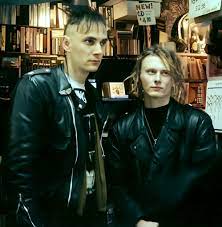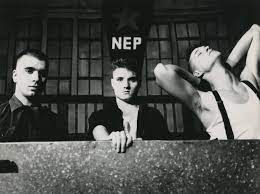Electronic Body Music
EBM: The Evolution and Impact of Electronic Body Music (EBM) in the 80s and 90s
Electronic Body Music (EBM) is a genre of electronic music that emerged in the late 1970s and early 1980s in Europe, particularly in Germany and Belgium. It is characterized by its hard-hitting beats, aggressive synth lines, and often politically charged lyrics.
The origins of EBM can be traced back to the industrial music scene of the late 1970s, which was heavily influenced by the sounds of bands like Throbbing Gristle and Cabaret Voltaire. These bands used electronic instruments and experimented with noise and soundscapes to create a new type of music that rejected the traditional structures of rock and pop.

One of the first bands to combine the sounds of industrial music with electronic dance beats was D.A.F. (Deutsch Amerikanische Freundschaft), a duo from Germany. D.A.F.'s early music was characterized by pounding drum machines, distorted synth basslines, and aggressive vocals that were often shouted in German. Their 1981 album "Alles ist Gut" is considered a classic of the EBM genre, and helped to establish the sound that would become synonymous with EBM.
Another key early EBM band was Front 242, a Belgian group that emerged in the early 1980s. Front 242 combined the hard-hitting beats of industrial music with the dance rhythms of disco and funk, creating a sound that was both aggressive and danceable. Their 1984 album "No Comment" is considered a landmark of the EBM genre, and helped to establish Front 242 as one of the most influential bands in the scene.
Nitzer Ebb, a British EBM band that emerged in the mid-1980s, also played a key role in the development of the genre. Like D.A.F. and Front 242, Nitzer Ebb used hard-hitting drum machines and aggressive synth lines, but their music also incorporated elements of punk and post-punk. Their 1987 album "That Total Age" is considered a classic of the EBM genre, and helped to establish the band as one of the most popular and influential acts in the scene.

Skinny Puppy, a Canadian band that emerged in the early 1980s, also played a key role in the development of EBM. Skinny Puppy's music was characterized by its use of industrial and experimental sounds, and the band's often confrontational and politically charged lyrics. Their 1984 album "Remission" is considered a classic of the EBM genre, and helped to establish Skinny Puppy as one of the most innovative and influential bands in the scene.
Throughout the 1980s, EBM continued to evolve and diversify, with many new bands and artists emerging and incorporating the sound into their music. The genre also became closely associated with the emerging club culture of the time, particularly in Europe, where clubs like Dorian Gray in Frankfurt, Germany, and Boccaccio in Belgium played a key role in popularizing EBM and helping it to become a cultural phenomenon.
In the 1990s, EBM continued to evolve and diversify, with many bands incorporating elements of techno, industrial, and other electronic music styles. However, the core elements of EBM remained the same: hard-hitting beats, aggressive synth lines, and politically charged lyrics.

One of the most popular and influential EBM bands of the 1990s was Front Line Assembly, a Canadian group that emerged in the mid-1980s. Front Line Assembly's music was characterized by its use of hard-hitting beats, aggressive synth lines, and heavy distortion, as well as its often dystopian and politically charged lyrics. Their 1992 album "Tactical Neural Implant" is considered a classic of the EBM genre, and helped to establish



ABOUT US
il Cabaret del Diavolo (Since 2005) was created for one reason, to bring together a mix of EBM Electronic Body Music and OldSchool Industrial of the 80's & 90's. But we play many others too of course such as SynthPop, DarkWave, Aggrotech, New Beat and Elektronische Musik. Long Live EBM!